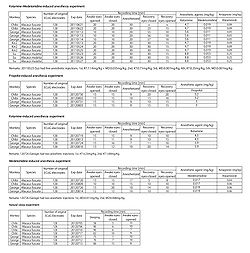Anesthesia Task Details
Anesthesia Task
Anesthesia task has five experiments.
- Anesthesia Experiments
- Ketamine and medetomidine (KTMD)
- Propofol (PF)
- Ketamine (KT)
- Medetomidine (MD)
- Natural Sleep Experiment (SLP)
Task illustration
- Anesthesia Experiments
- Natural Sleep Experiment
Detail Method
- Anesthesia Experiments
We did 4 experiments in which the monkey was under anesthesia. Two anesthetic agents, ketamine and medetomidine, were used in the first experiment. In other experiments, only propofol, ketamine or medetomidine were used respectively.
During the experiments, a monkey was seated in a primate chair with both arms and head movement restricted. Neural data were acquired during the experiment. There were three conditions that were awake, anesthetized and recovery conditions. The awake condition had eyes-opened and eyes-closed conditions. At first the monkey’s eyes were opened and the monkey would sit calmly for up to 20 min (See Table). Next the monkey’s eyes were covered by an eye-mask to refrain from evoking visual response. During the eyes-closed condition, the monkey would sit calmly for up to 20 min at which time we would start to monitor heart rate (See Table).
In experiments where the ketamine-medetomidine cocktail was used to induce anesthesia, the ketamine (~5.0 mg/kg for M1–M3, 8.8 mg/kg for M4) and medetomidine (~0.016 mg/kg for M1–M3, 0.053 mg/kg for M4) were injected intramuscularly (see Table). In contrast, propofol-induced anesthesia was achieved through intravenous propofol (5.2 mg/kg for M1 and M2) injection (see Table). In ketamine-induced anesthesia experiment, the ketamine (~5.1 mg/kg for M1 and M2) was injected intramuscularly (see Table). In medetomidine-induced anesthesia experiment, the medetomidine (~0.018 mg/kg for M1 and M2) was injected intramuscularly (see Table). Loss of consciousness (LOC) was defined as the point at which the monkey no longer responded to manipulation of the monkey’s hand or touching of the nostril or philtrum with a cotton swab. As an additional confirmation that the monkey had achieved LOC, we could observe slow wave oscillations in the neural signal. After LOC was established, neural activity was recorded for up to 30 min for the ketamine-medetomidine-induced anesthesia experiment, and about 10 min for the propofol-, ketamine-, and medetomidine-induced anesthesia experiments respectively (Anesthetized condition). Heart rate and breathing were monitored carefully throughout the length of the experiment.
After the anesthetized condition, the monkey recovered from anesthesia (Recovery condition). In ketamine-medetomidine- and medetomidine-induced anesthesia experiments, atipamezole which is an antagonist of medetomidine was injected intramuscularly and the monkey recovered quickly after the injection. In propofol- and ketamine-induced anesthesia experiments, the monkey was left alone for recovery. In the recovery condition, there were eyes-closed and eyes-opened conditions. In ketamine-medetomidine-induced anesthesia experiment, the onset of recovery eyes-closed condition was defined as the point at which the slow wave oscillation in the neural signal disappeared. In propofol-, ketamine- and medetomidine-induced anesthesia experiments, the onset of recovery eyes-closed condition was defined as the point at which the monkey responded to manipulation of the monkey’s hand or touching of the nostril or philtrum with a cotton swab as same sensitivity as the awake eye-closed condition.
During the recovery eyes-closed condition, the monkey’s eyes were closed and the monkey would sit calmly for 10~30 min. Next the monkey’s eyes were opened by removing the eye-mask. During the recovery eyes-opened condition, the monkey would sit calmly for about 10 min.
We performed two to three experiments for each monkey, all on separate days (See Table).
- Table
- ECoG Electrode array on monkey's brain
2D brain image and electrodes location of monkey can be downloaded here.
Data format
Data can be download from neurotycho.
One zip file has one date data which consists of some sessions.
In the name of the zip file
(ex. 20110621KTMD_Anesthesia_Chibi_Toru+Yanagawa_mat_ECoG128.zip)
1) The first numerical number (ex. 20110621) means an experimental date
2) 'KTMD‘, ‘PF‘, ‘KT‘, ‘MD‘ and ‘SLP‘ mean label of experiment
3)‘Chibi‘, ‘George‘, ‘Kin2‘ and ‘Su‘ mean name of monkey
In each session folder (Session*), there are ‘ECoG_ch**.mat‘, ‘ECoGTime.mat‘ and ‘Condition.mat‘ files. * means number of session.
‘ECoG_ch**.mat‘ had ECoG data of electrode. ** means number of electrode. Sampling rate was 1 kHz.
‘ECoGTime.mat‘ had time of ECoG data.
‘Condition.mat‘ had information of condition.
Only the sleeping experiment had EOG and EMG data.
‘EOG_REye.mat‘ had EOG data recorded from right eye.
‘EMG_Chin.mat‘ had EMG data recorded from chin.
Condition information:
‘Condition.mat’ has information of condition in the session. There are four variables:
‘ConditionLabel‘ has labels of condition.
‘ConditionIndex‘ has indices of data at which conditions occurred in the session.
‘ConditionTime‘ has time-stamps at which conditions occurred in the session [sec]
The meaning of label of condition is as follows:
'AwakeEyesOpened': Awake condition with eyes opened
'AwakeEyesClosed': Awake condition with eyes closed
'AnestheticInjection': Injection of anesthetic agent
'Anesthetized': Anesthetized condition
'AntagonistInjection' : Injection of antagonist
'RecoveryEyesClosed' : Recovery condition with eyes closed
'RecoveryEyesOpened' : Recovery condition with eyes opened
Reference
Yanagawa, T., Chao, Z. C., Hasegawa, N., & Fujii, N. (2013). "Large-Scale Information Flow in Conscious and Unconscious States: an ECoG Study in Monkeys." PloS one, 8(11), e80845.




